Once upon a time, every seagoing sailboat had a broad table in the saloon with sightlines to the helm, plenty large enough to spread out a big NOAA chart folded in half. Of course, that meant your boat couldn’t offer other things, particularly if it was smaller than 40 feet. Queen-size berths and separate shower stalls? Not likely.
But the times and designs have changed. Cruising World‘s Boat of the Year judges examined roughly two dozen new sailboats in October 2017, and in so doing, we marked the ways today’s builders either hewed to tradition or innovated with their boats’ navigation stations.
The Traditionalists
Big chart tables aren’t entirely gone. Six boats in this year’s fleet of new boats exhibited traditional nav stations with ample room to slide parallel rules and swing a pair of dividers. The smallest of these was the Hallberg-Rassy 412, whose very name evokes traditional design. Situated to starboard just forward of the companionway steps and across from the galley, this forward-facing nav station features a hinged surface that opens into a space large enough to contain a couple of ChartKits and a full suite of plotting tools. It places the navigator in easy reach of the orderly electrical panel. On the boat we sailed, a single-sideband radio was installed in the outboard corner, with a shelf above it for smaller items. Hallberg-Rassy’s always exquisite mahogany joinery incorporates a high fiddle on the table’s inboard edge to catch rolling pencils, and no fiddle on the aft edge to interfere with arms and elbows.
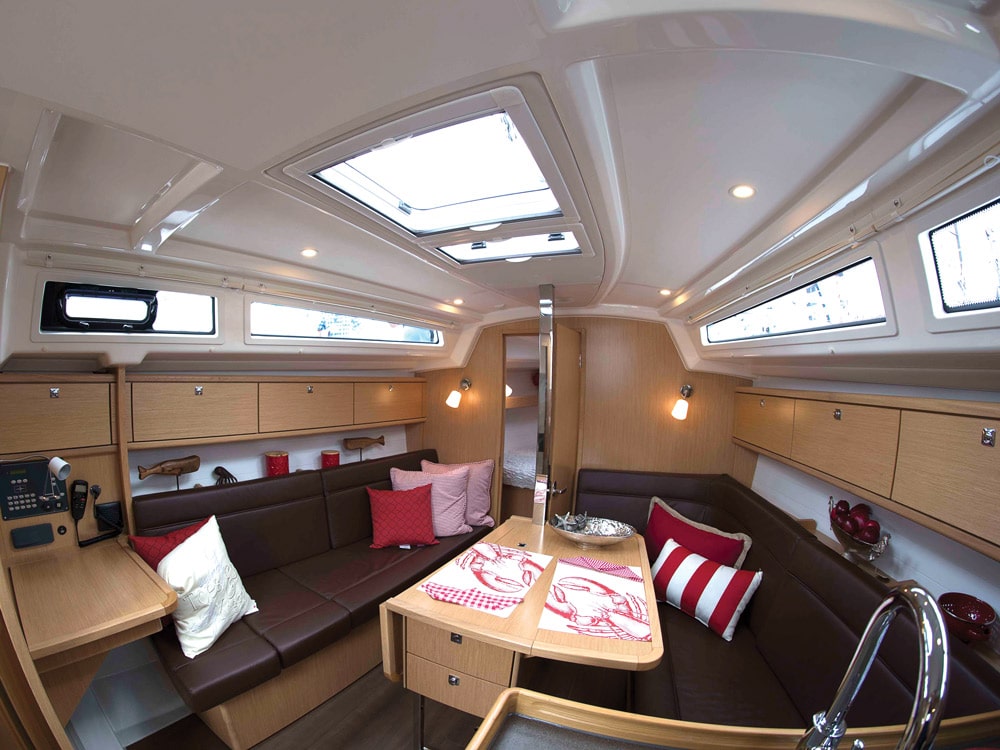
Likewise, the Gunfleet 43 provides storage for charts, and the surface to use them, at its forward-facing station. On a bulkhead angled in at 45 degrees, you can mount a multifunction electronic display, comfortably visible without craning your neck.
Two boats from Jeanneau — the Jeanneau 51 and the Jeanneau Sun Odyssey 440 —incorporate forward-facing chart tables into their cabins on the port side. Of these, the table on the 51 was understandably bigger, with a storage space underneath the hinged surface. The fiddles aren’t as high as those on the HR 412, but they’ll still hold a chart (or a pencil that hasn’t gathered up too much speed). The electrical panel on the outboard bulkhead easily shares space with the VHF mic, genset controls and a 4.5-inch Raymarine instrument display. A particularly nice treat here is the autopilot remote, which allows the navigator to make course adjustments while working with the chart.
The Jeanneau Sun Odyssey 440 won CW’s 2018 award for Most Innovative. Interestingly, while incorporating other bold new ideas with the deck layout, its creators preserved a relatively large forward-facing nav table. As its bigger sister has done, the 440 brings instruments and monitors within easy reach of the navigator.
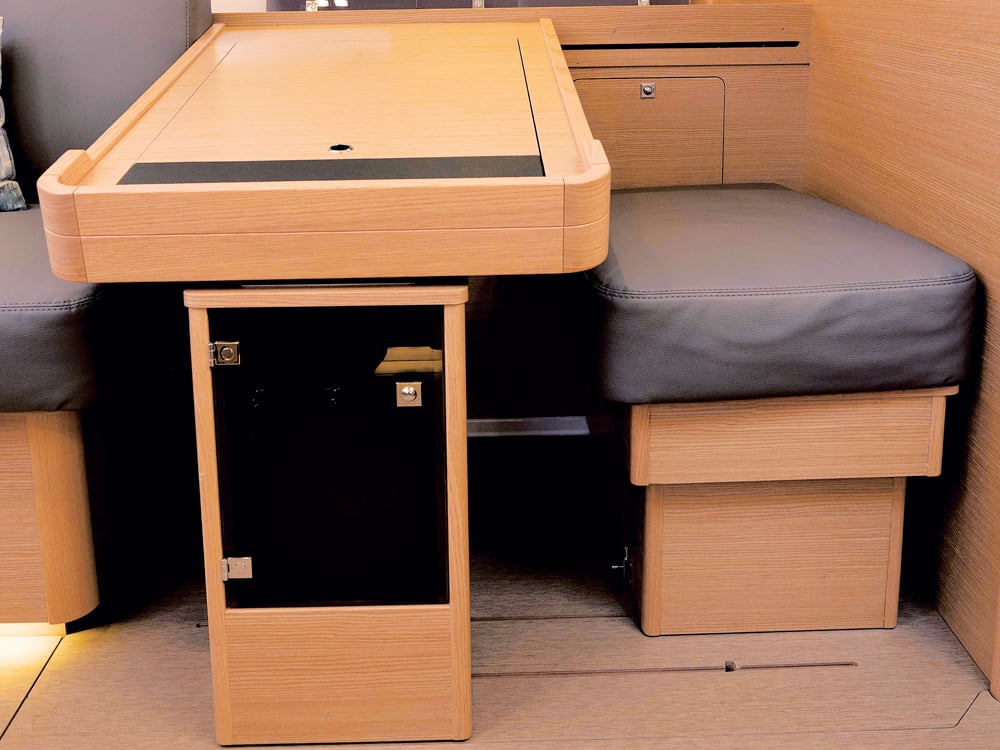
This year’s new Swan 54 was another boat that blended traditional design with new thinking. Long known as a builder that exemplifies the sweet spot between top performance and true cruising credentials, with its latest models Nautor’s Swan has made a clear distinction along those lines. While the Club Swan 50 is a full-on raceboat, the Swan 54 is committed more clearly to cruising. Its forward-facing nav station sits forward in the main saloon, hard by the main bulkhead. With room for a 12-inch multifunction display, as well as several smaller ones, this provides a position to navigate by analog or digital means with superb ergonomics.
The largest boat in our fleet, the Oyster 745, also features one of the largest nav stations among the monohulls. This aft-facing desk area, on the port side of the companionway, will serve its owners and crew as an ample office space. This station has room for two large multifunction displays, plus smaller instruments. On the boat we sailed, MFDs were also installed in the sleeping cabins.
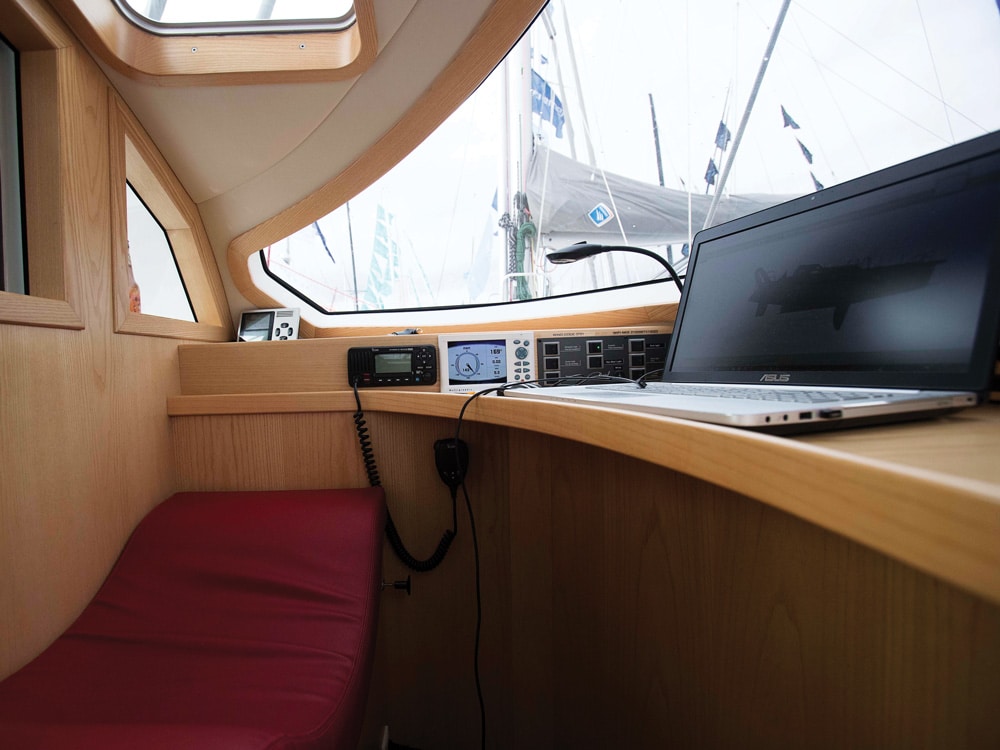
The Laptop-Style Office Space
Two of the boats from this year’s fleet, at opposing ends of the length scale, devote the area of a full-size traditional nav station to other purposes. The Bavaria Cruiser 34 was the one boat with complete cruising amenities in our Pocket Cruiser category — and, fittingly, it was the winner of that category. To make room for a spacious head and aft cabin in the boat, the designers placed a small table at the aft end of the port settee, and with room under the table to hang your legs. It’s a comfortable place to work on a laptop, but it’s not a place where you’ll be able to spread out a chart. In the context of its design brief, we applauded the choice.
Toward the other end of the length continuum is the Beneteau Oceanis 51.1. For well over a decade now, Beneteau has led the pack in interior styling. Indeed, the company employs the Nauta Design firm exclusively for the interior, distinct from the hull form created by Berret Racoupeau. The saloon of the 51.1 is uncommonly open and flooded with light. One contributing detail is a smallish nav table portside and forward at the main bulkhead. The seating for this table is a reclining lounge chair installed athwartships; sitting at 90 degrees facing forward gives access to the table, which provides basic navigation monitors and reasonable space for working on a computer.
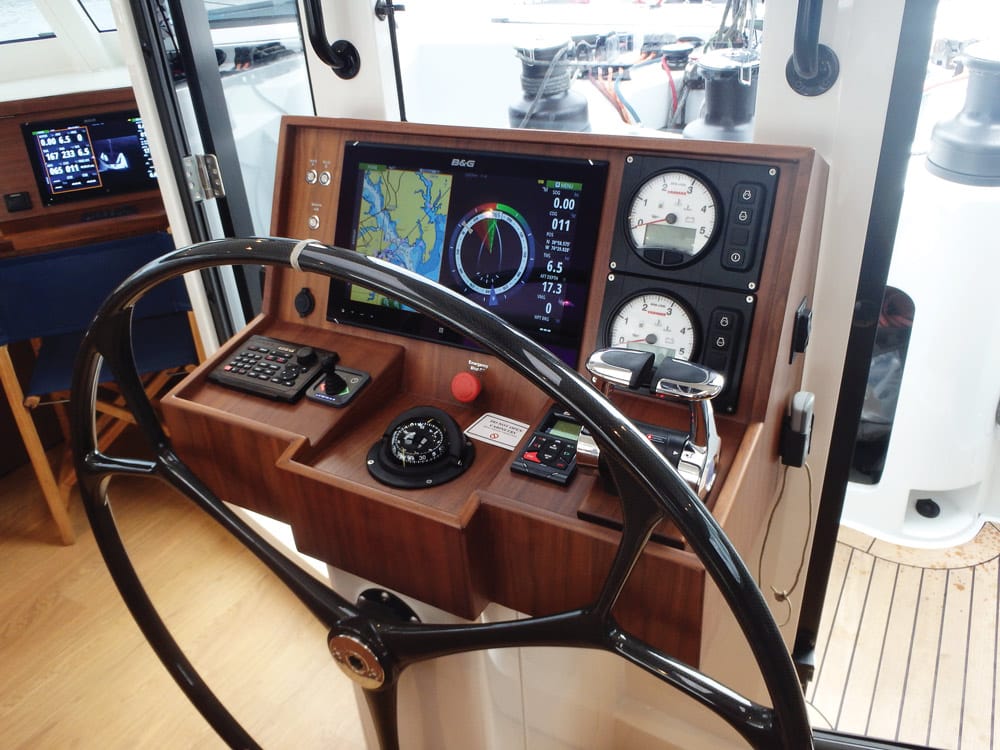
The Transformers
Every yacht designer reckons with the fact that we expect a boat’s interior to serve us equally well in radically different contexts. We might be sharing laughs with a half-dozen pals in a calm anchorage, or we might be underway, slamming into a nasty chop. Four boats in this year’s fleet offered variable designs that responded individually to each of these situations.
The aluminum-hulled Allures 45.9 features a deck-saloon cabin top and a raised table that affords some visibility under sail through the deck’s forward portlights. Like a high-top table in a restaurant, this platform places you above the level of those seated at the dinette, and it has seats both forward-facing and aft-facing. Facing aft affords good sightlines to the helm.
The Hanse 588 addresses the design tension of a boat’s different uses with an elegantly simple solution: The nav station and the dinette share a single settee. By articulating the backrest forward or aft, you can use that single seat for either use.
The Elan GT5 — winner of its Midsize Cruiser category — is a boat filled with innovative touches. One of these is a nav table forward and to starboard that slides up to create a smallish nav table or slides down to accept cushions and become part of a longer settee.
The boat most deserving of the transformer name is the Dufour 520. The starboard-side nav table slides forward, for a forward-facing nav station at sea, or aft, for a longer settee when the boat is in entertainment mode. Not only that, but its inboard leg can be raised or lowered to provide a flat writing surface when the boat is heeled.
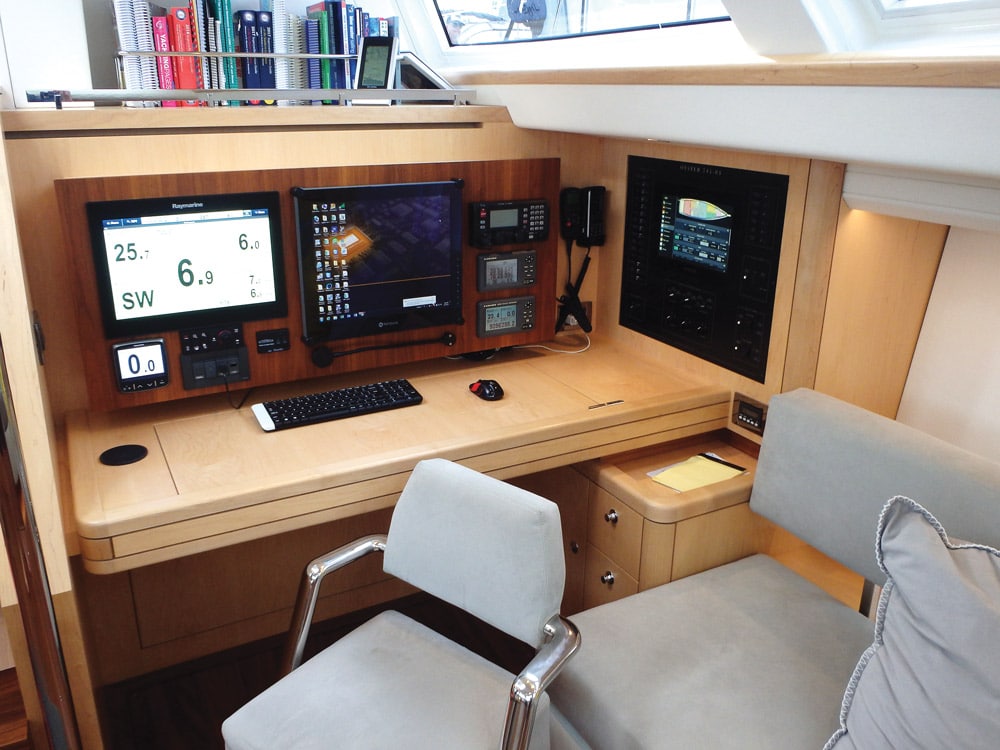
The Pilothouses
The word “pilothouse” might conjure images of old-school, heavy-displacement motorsailers. The 2018 fleet shows us how far off base that stereotype can be — and how far yacht designers have come in the past several years. The boats in this roundup are some of the lightest on the water, and provide some of the best combinations of visibility and shelter that have ever been available in a cruising boat.
Three light cats stand out. The Maine Cat 38 is a speedy boat that can be sailed almost entirely from inside the enclosed bridgedeck. Not just the nav station but the boat’s entire workstation (halyards, sheets and winches, as well as the helm) is installed behind tempered-glass windows at the forward end of the coachroof. All electronic nav instruments are within easy view of the helm.
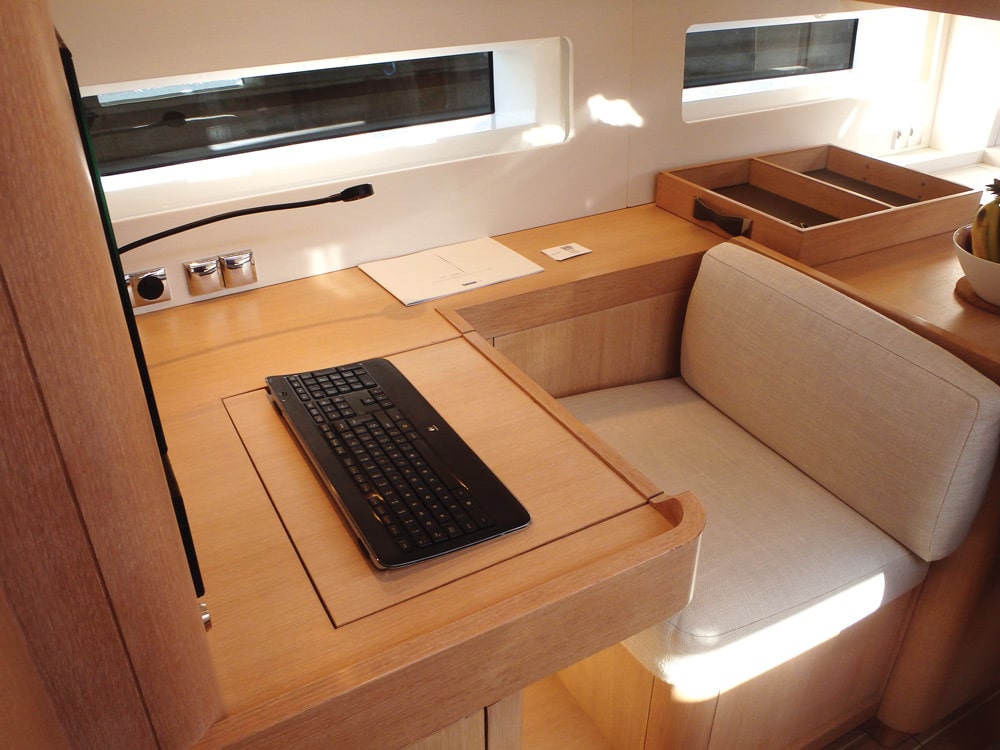
Two performance catamarans from one builder — the HH 55 and the HH 66 — exhibit similar near-360-degree visibility from the inside helm station. In these boats, you step outside through a gasketed door for sailhandling tasks, but the visual connection between the virtual world of electronic charts and the physical world of wind and water exhibited in these contemporary catamarans can’t be beaten.
The Fountaine-Pajot Saona 47 presents a nav station that adroitly connects the physical and virtual worlds better than all the previous categories. But in a distinction from the previous three cats, this nav station is separated from the outside helm and sailhandling station at the aft end of the cabin house. With a high-cut headsail, the navigator has superb visibility through the forward 225 degrees, better than the visibility from the raised helm.
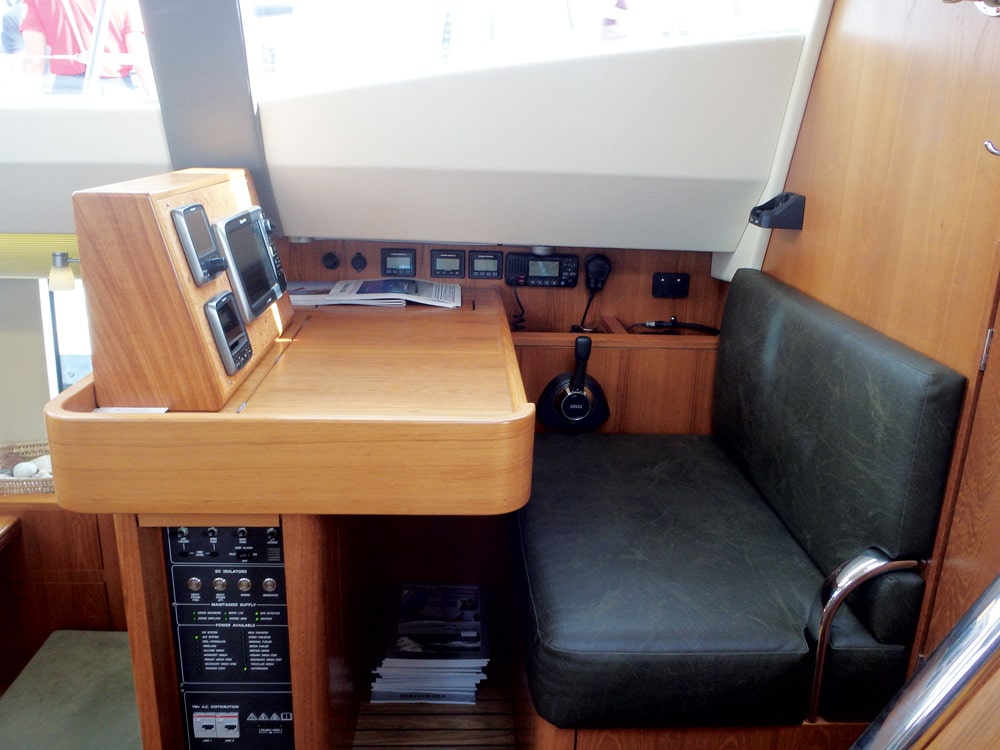
Three monohulls offered three very different iterations of the pilothouse concept. The Discovery 58 is a Ron Holland design of robust displacement with a full-size nav station that provides visibility through forward windows in the deckhouse, even when the boat is at rest. Similar to the Jeanneau 51, the Discovery we sailed had an autopilot remote installed beside the nav seat, but no engine controls. Finally, this boat’s layout features a large countertop, big enough for an entire chart, forward of the nav station.
In the Southerly 540, winner of the big Full-Size Cruiser category, we have a true pilothouse arrangement, with both autopilot and electronic engine controls. Not only that, but this boat’s swing keel opens access to deep water and shallow.
The overall Boat of the Year winner of 2018 also featured one of the most interesting pilothouse arrangements. The Boreal 47, built in France of aluminum, brings together a hard dodger that encompasses both doghouse-style protection in the cockpit and a fully enclosed pilothouse behind a gasketed door. Once inside, the pilothouse is at the level of the cockpit sole; to enter the cabin, you descend several steps from there. This design impressively answers the boat’s go-anywhere promise.
Tim Murphy, a CW editor at large and a longtime Boat of the Year judge, is sailing his 1988 Passport 40 Billy Pilgrim on the U.S. East Coast, and fitting her out for longer distances.








